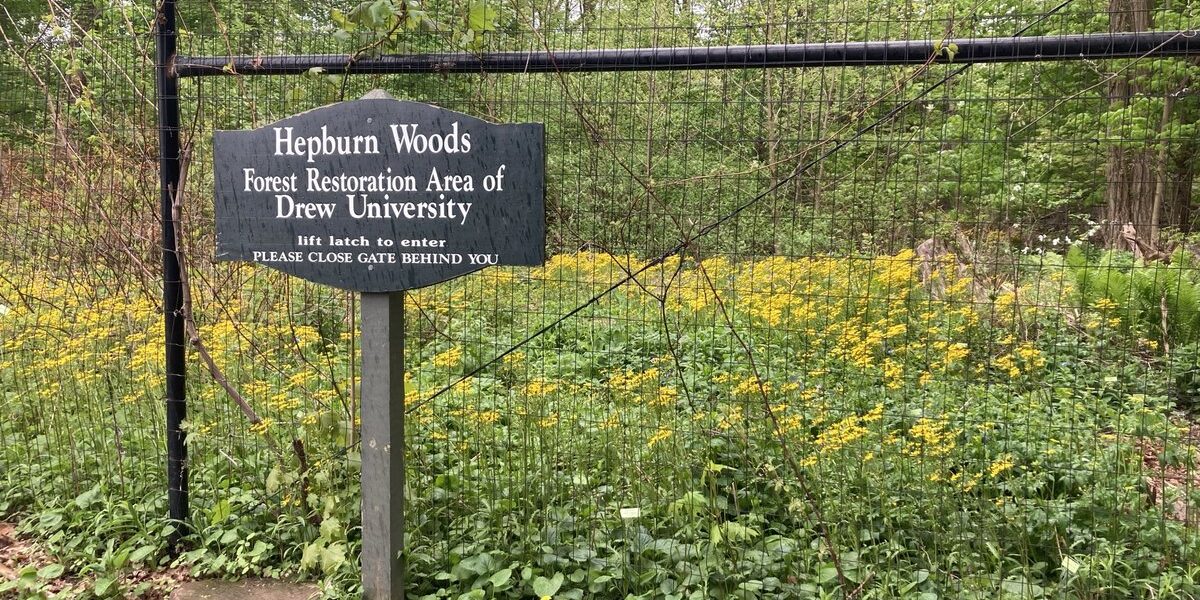A housing trial set to start on Monday could put North Jersey’s treasured Drew Forest at risk of housing development that locals say would harm a jewel of biodiversity and important water resource.
Drew University in Madison wants to sell three plots of land — including its 53-acre forest property – as it struggles with declining enrollment and the pandemic’s financial effects. Drew attorney John Inglesino said the school’s been trying to work out a “multipronged” deal for years: get Madison to rezone the two remaining plots of land — about 11 acres in total along the edge of the campus — to allow for housing, so it can sell those plots to a developer. Then sell the forest to Madison for conservation, preserving the ecological resource forever.
The school would earn millions of dollars in exchange for its lands.
Madison officials say they want the same, in principle. But for more than two years, they’ve failed to reach an agreement over how much housing should be allowed on the land. Drew successfully sued Madison in 2022, convincing a judge all three parcels — including the forest — should have been taken into account as developable property when the borough worked out its obligations to build affordable housing under state law. The omission undercut the value of all three of Drew’s parcels, school officials said.
Now, if they can’t come to an agreement before heading to court on Monday, a judge will decide the properties’ “realistic development potential,” or how much affordable housing they can accommodate in the context of the borough’s obligations. That would take the matter of density out of Madison’s hands, and could require it to allow housing on all three properties. And if that happens, Drew officials won’t rule out selling the forest to a developer, instead of the borough, which hasn’t yet been able to raise enough money to buy the forest at the fair market price Drew wants.
Inglesino said he’s still hoping Madison and Drew will reach a settlement that makes a court ruling unnecessary, and avoids putting the forest in jeopardy of development.
“The scenario we would like to avoid … is a decision from the judge that, in practical reality, would force Madison to permit development on all of Drew’s surplus lands, including the forest,” Inglesino added.
Years of failed negotiations
In the 2022 court case, Drew alleged the borough deliberately ignored its lands when sizing up how much property was left in Madison for potential development. Borough officials reject that assertion. Including those properties in the plan, along with a decision on the development potential of the three parcels, will likely increase how much affordable housing the court requires Madison to accommodate.
“So when land becomes available that’s a big deal because now you’ve got land that’s been offered up for housing,” said Rachel Lokken, attorney for the nonprofit Fair Share Housing Center, which negotiates plans with communities to satisfy their affordable housing obligations.
Madison Mayor Bob Conley, who is currently in his fourth term, acknowledged that discussions between the borough and Drew over the redevelopment of land in the years leading up to the lawsuit had not gone well.
“Probably from their point of view they were frustrated at the progress we were making,” Conley said.
According to court records, Drew is hoping for zoning that would allow 30 units per acre on the two properties it hopes to sell to a developer — or more than 300 units in total. But Madison is offering to zone the property for only 6 units per acre — amounting to just several dozen units.
“That developer wants to develop at a high density. So that’s where the biggest disagreement is,” Lokken said.
The Fair Share Housing Center is a party in the case since it will also need to sign off on Madison’s plan to satisfy its affordable housing obligation. Lokken said Fair Share also wants to see this case settled, and the forest preserved.
The contract purchaser of the two parcels Drew aims to develop is AvalonBay, a major player in New Jersey multiunit housing development, particularly in the suburbs. AvalonBay declined to comment for this story.
From ‘depressing’ to flourishing
Sara Webb, an ecologist and professor emeritus at Drew, is in her fourth decade at the university. She’s also the school’s restoration program director. Rather than teach a course schedule, Webb spends her days clearing garlic mustard weed, which smells good but kills off other vegetation; occasionally donning a hazmat suit and pulling up poison ivy; and clearing fallen trees — whose trunks she leaves on the ground so they continue capturing carbon.
“This is carbon defense. This is climate defense right here,” she said on one of her walks through the forest.
Instead of pulling downed trees out of the forest to be ground down, Webb takes a reciprocating saw — which she called “the most romantic gift I’ve ever received for Christmas from my husband” — to their bark and makes sure to clear the logs off the walking path.
Webb said that two decades ago, the forest was a “pretty depressing place” whose survival was in jeopardy. She watched it deteriorate for years. Invasive plant and tree species rendered it impossible for diverse plant life to flourish, and deer ate up whatever flora didn’t get killed by other plants.
Webb began to lead a major restoration effort of the forest in 2008. Together with her students and other volunteers, she began clearing the invasive plants and planted hundreds of native shrubs and over 2,000 new tree seedlings in their place. Many of them were donated from a tree-growing program run by the state penitentiary in South Jersey. They also erected a 10-foot tall deer fence. And now, if a deer breaks in, Webb assembles a team to chase the hoofed invader out of the forest. Because of this work, Webb said, the forest is now a sustainable place.
“There will be a forest in the future,” she said.
Webb said the desire to see the forest spared from housing development through a conservation purchase is not just about “tree hugging.” Along with capturing carbon through its trees, the forest is also an important water resource in the region that helps prevent floods and provides drinking water. She said around 30 towns tap into water that the terrain soaks up like “a sponge,” which is then naturally “filtered, purified and slowly released” throughout the region.
“Even if you don’t even care about big trees or the biodiversity of the future forest … you care about the flooding that we’ve been seeing, you care about the water shortages that we see and the quality of the water,” she said.
Locals hope for a ‘win-win’
Friends of the Drew Forest, a nonprofit organization that is trying to save the forest from development, has raised $9.1 million through donations and grants that would be put toward the borough’s potential conservation purchase, according to group co-chair Judy Kroll. That includes a “huge earmark” of $4.1 million in federal funds Rep. Mikie Sherrill and Sen. Cory Booker recently secured.
Gov. Phil Murphy has proposed another $2 million for preserving the forest in his state budget, which remains under negotiation with the Legislature. A conservation deal would prevent development indefinitely — but may not be possible at all without an agreement over how to handle the remaining two properties.
Kroll said that in order to get a deal done, Madison and the group need more than the millions that they’ve already raised — and she’s not even sure how much. The Friends group estimates developable residential or commercial land in Madison goes for about $450,000 to $500,000 an acre. But Kroll said the Friends group is not involved in those negotiations between Drew and Madison.
Conley said he cannot share the actual amount necessary to close the conservation purchase deal.
“The $9 million in grants is a great start to our funding goal but we have a way to go,” he said.
In the meantime, Kroll said, the Friends group isn’t not currently fundraising as members await the outcome of the court case.
Webb, Drew’s restoration director, is hoping for a “win-win.” And for her, how to achieve it is clear: Let Drew “do what you want” to the other properties being considered for development, she said. That way, the university she loves can continue to flourish.
But, she said, “leave the forest alone.”





